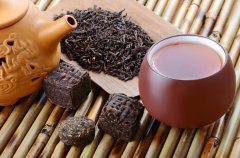The Natural reasons for the good quality of Kenyan Tea main Distribution and Taste characteristics of Kenyan Tea
Kenya in East Africa is the world's third largest tea producer (fourth in the past few years) and the only country in Africa that produces large amounts of tea for the world market. Recently, it has also become a major source of innovation for new tea varieties and single-origin craft tea.
Unlike India and Sri Lanka, where most tea is grown in large plantations, 90% of Kenya's tea is grown on an acre or less farm, which is the center of Kenya's economy; tea exports account for 26% of total export revenue and about 4% of gross domestic product.
Kenyan tea farmers have become nervous because of competition; Kenya has decided to invest in the research and development of new tea varieties, rather than expanding their operations, which are likely to achieve higher yields and better adapt to changing climatic conditions.

Climate and tea production in Kenya
Located at the equator, Kenya has a semi-arid tropical climate, with grasslands and semi-deserts in low-lying areas and mountain forests at high elevations. The climate in most parts of Kenya is too dry to grow tea; tea-growing areas in Kenya tend to be concentrated in high-altitude areas in the west of the country because of higher rainfall and lower temperatures.
Kenya borders Tanzania in the south, which is another important tea-producing country in Africa.
Kenyan handmade tea, specialty tea and single manor tea
Although Kenya is a major player in the global market, it is less well-known as the source of American tea. Most of the tea produced in Kenya is black tea in bulk and is used for blending. However, Kenya's specialty tea industry has boomed in recent years, and green and white tea are now produced in Kenya, including new teas such as white matcha tea. Kenya is also a place to develop new varieties of tea, including purple tea, a tea tree rich in purple anthocyanins, blueberries and raspberries contain the same pigment.
Kenyan tea producing areas
[Carejo Kericho]
Karijo is a district (county unit) of southwestern Kenya, located on the western edge of East Africa's Great Rift Valley province, bordering Nyanza province. Unlike much of semi-arid Kenya, Karijo is located at high altitudes with extremely high rainfall, usually every day. These climatic conditions, coupled with high altitude, make it an ideal place to grow tea trees. The area is naturally covered with evergreen forests, so it is called the evergreen Creek Heights.
This area is home to most of Kenya's tea industry. In addition to small companies such as Chim Chim Tea, large companies, including Unilever, also have tea operations in the region.
Milima estate, formerly known as Kenya Marinyn estate, is located here, and Kaproret estate.

[Kisi Kisii]
Kisi is a region of western Kenya located in Nyanza province.
The Keith hills are undulating and high above sea level, reaching about 2000 meters in some places; most of the region is such a rural area with highly developed agriculture and high population density. Of the more than 1 million people, less than 10% live in urban areas, but the population density in this area is almost twice that of New Jersey, the most densely populated state in the United States. The area was initially completely forest, but due to the expansion of agriculture, there are only small, isolated forest debris left in the area.
Nyansiongo Tea Factory is located in Kisi.
[Nandi Nandi]
Nandi is a district (county unit) of Kenya, located in the Great Rift Valley Province of East Africa. Most of the Nandi region is covered by Mount Nandi, an important area of tea production in Kenya. The tea industry is the economic center of the region. Nandi is also the birthplace of many famous Kenyan long-distance runners.
Nandi's climate has a bimodal dry and wet precipitation model. in the rainy season before and after the Spring Equinox, the sun is farther from the equator, while in the dry season before and after the Spring Equinox, the sun is more directly above the head.
Tinderet Manor is located here, near the border of Kericho County. Someone mistakenly listed the manor in Carejo County.
Important Notice :
前街咖啡 FrontStreet Coffee has moved to new addredd:
FrontStreet Coffee Address: 315,Donghua East Road,GuangZhou
Tel:020 38364473
- Prev

Basic knowledge of six tea types and correct brewing methods what are the basic characteristics of tea?
All teas come from the same plant Camellia, however, there are many different varieties and varieties of plants. All the tea has withered. Wilting is the evaporation of water from leaves. Here is a simple explanation of production. White tea is picked, withered and baked. Green tea is picked and then steamed or fried to stop the process of oxidation and fermentation to neutralize active enzymes. The leaves withered after cooking
- Next

The difference between Tuo tea and Pu'er tea is Tuo tea raw tea or cooked tea? Who is not suitable for drinking Tuocha?
Tuo tea is compressed in the shape of a bowl, mainly produced in Yunnan and some cities in Chongqing. It is made of black tea, usually Pu'er tea. Yunnan Tuo Tea, also known as Pu'er Tuo Tea, was founded in 1917. Chongqing Tuocha was founded in 1953. Yunnan Tuo tea is more famous than Chongqing Tuo tea, so Tuo tea generally refers to Yunnan Tuo tea or Pu'er tuo tea. The history of Tuo tea has a history of production.
Related
- Beginners will see the "Coffee pull flower" guide!
- What is the difference between ice blog purified milk and ordinary milk coffee?
- Why is the Philippines the largest producer of crops in Liberia?
- For coffee extraction, should the fine powder be retained?
- How does extracted espresso fill pressed powder? How much strength does it take to press the powder?
- How to make jasmine cold extract coffee? Is the jasmine + latte good?
- Will this little toy really make the coffee taste better? How does Lily Drip affect coffee extraction?
- Will the action of slapping the filter cup also affect coffee extraction?
- What's the difference between powder-to-water ratio and powder-to-liquid ratio?
- What is the Ethiopian local species? What does it have to do with Heirloom native species?

